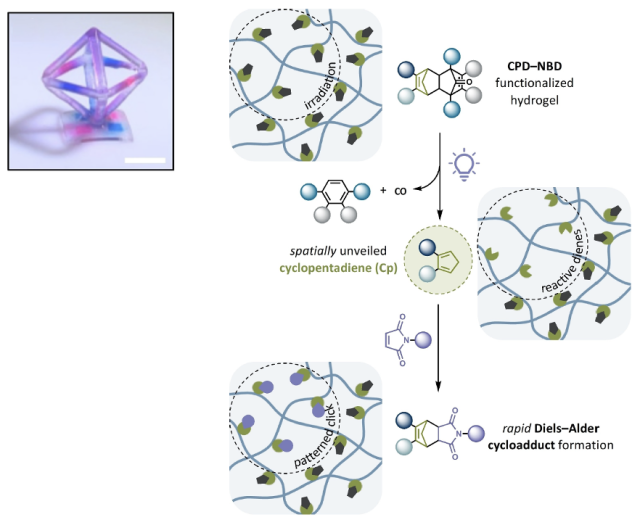Design, Synthesis, and Application of a Water-soluble Photocage for Aqueous Cyclopentadiene-based Diels-Alder Photoclick Chemistry in Hydrogels

PIs and Institution
Sophia J. Bailey, Erik Hopkins, Juan Manuel Urueña, Maxwell Z. Wilson, and Javier Read de Alaniz, UC Santa Barbara
Achievement
Hydrogels with functional groups that enable selective modification of specific regions in response to external stimuli have exciting applications in tissue engineering. However, their preparation often relies on radical-based strategies that can be deleterious in biological settings. This paper describes the achievement of a computationally guided design, synthesis, and application of a water-soluble molecule that acts as a photoremovable protecting group, or photocage, for radical-free Diels-Alder photopatterning. By incorporating a cyclopentadienone-norbornadiene (CPD-NBD) photocage into hydrogel formulations, then “uncaging” it under 365 nm illumination, the researchers successfully achieved spatial control over cyclopentadiene-based click chemistry with dienophiles in pre-determined locations. The patterning was visualized using cyanine dyes, and biological utility was demonstrated by patterning peptides to direct cellular adhesion. The CPD-NBD derivative was also incorporated into a commercial 3D printing resin, enabling the photopatterning of structurally complex, printed hydrogels.
Importance of the Achievement
By introducing the CPD-NBD adduct as a photocage, the researchers provide a scalable and versatile method for patterning hydrogels without relying on radical mechanisms. This approach increases compatibility with various commercially available dyes, biomolecules, and proteins. The ability to pattern hydrogels with high precision and control using non-radical-propagating photo-click reactions opens up new possibilities for creating biomimetic hydrogel scaffolds and advancing tissue engineering technologies. Additionally, the use of a photocleavable molecule like CPD-NBD expands the toolbox of photopatterning strategies, allowing for the patterning of radical and photo-sensitive biomolecules and matrices, further enhancing the advancement of biomimetic hydrogel scaffolds.
Unique Features of BioPACIFIC MIP that Enabled this Achievement
In this study, the researchers utilized BioPACIFIC MIPs Additive Manufacturing facility for 3D hydrogel printing. The collaboration with BioPACIFIC MIPs project scientist Juan Manuel Urueña played a crucial role in optimizing the 3D printing of the samples. Moreover, student Sophia Bailey was supported as a BioPACIFIC MIP Fellow.